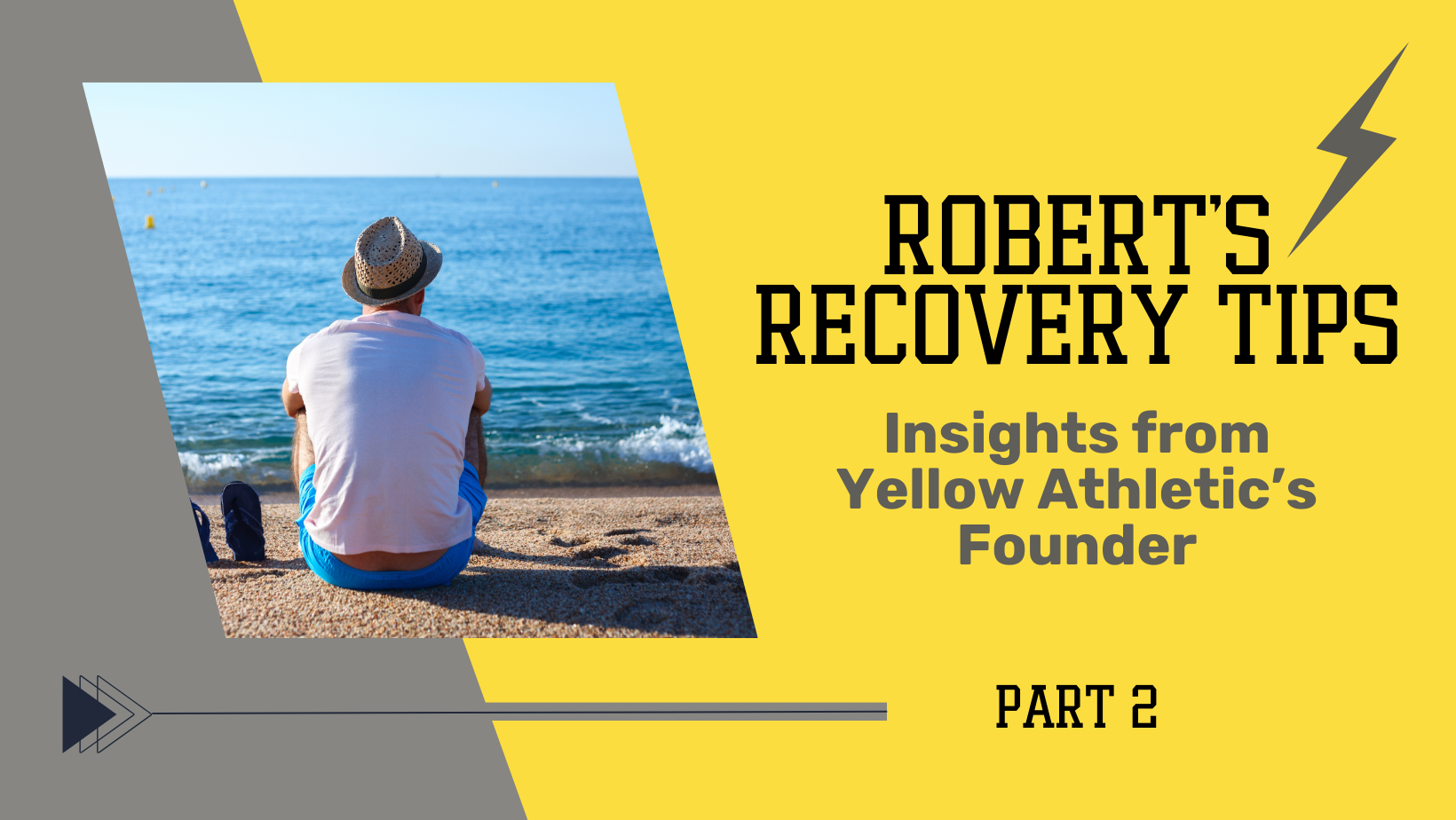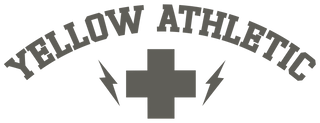
I’m Robert, founder of Yellow Athletic, and I’ve been on a journey to understand and overcome challenges that have kept me from doing what I love: getting out there playing sports and being active. This article is Part 2 (Part 1, here) of my recovery journal tips, compiled with our Medical Director Dr. Morgan. Thanks for allowing me to share my experiences with you!
Sleep
A person could spend days combing through the research, tips, advice, and products on sleep. I’ve done that for you and will boil it down to a 3-minute tutorial. Haha, there's no way I’m capable of that. But I can share some simple advice about what I've been doing to sleep better. I keep a regular schedule; other than the 1-2 nights where I might go out with friends, or play soccer. My body clock starts shutting down hard around 10:20. I think ahead, I stop drinking water around 8, don’t eat anything other than a light snack after 7pm, and I dim the lights in my house. I also do my bedtime routine (brushing teeth etc.) one hour or so before bedtime so when I’m tired I can simply fall into bed without the hassle. And there’s a bonus: after I've brushed my teeth, my desire for sweets or snacks disappears. I also take CBD Sleep Oil about 30 minutes before my targeted bedtime. My wife says once I hit the pillow I seem to be instantly asleep. It wasn’t always this way, and I credit my lead-up-to-sleep ritual. Research suggests an optimal window of time presents itself for when it's easiest to fall asleep: heed the call and don’t do that one more thing. Certainly, don’t mindlessly scroll through social media just before bed. I could step up my sleep game even more by turning off the television thirty minutes before bed and replacing that time with reading, meditating, or chatting with my wife. But what I am doing is working. I sleep better now than in the prior 30 years.
Meditate
I have difficulty sitting still, and clearing my mind of thoughts, so meditation in the traditional sense is challenging. If you don’t like the rules, change the game! I meditate by sitting at the beach for an hour on the weekends. I do this alone, without a book or phone. Just a chair and a beverage. This is mediation for me; I find it therapeutic. I smile and laugh for no reason. But there is science to what I’m doing. Digging my feet and hands in the sand takes advantage of grounding, a healing connection to nature, and reduces stress. Another form of meditation I embed in my morning routine is making a cup of coffee and then practicing gratitude journaling or reading an inspirational book on positive thinking (I’m currently rereading Manifest). I take 20-30 minutes each morning to make sure I start the day on a positive note; good vibes and energy follow.
Soak
Sitting in the bathtub can feel great in the cooler months. Warm water, Epsom salt, candles, and a favorite mellow music playlist feel amazing. The stress drains out of my body over the 45-60 minutes I do this. Occasionally, I treat myself to a water spa with warm baths, cold plunges, a steam room, and a sauna. Cold water therapy, like the Wim Hof Method, is also something I’d like to try; it involves breathing techniques and cold exposure via ice baths in nature or at home. Whether it's warm or cold water, a soak can do you some good.
Reduce (inflaming foods)
Whenever I read the labels for sugar content on drinks, I cringe; some have over 50 grams of sugar, more than an entire day's allowance. So, I swap out sugary drinks for unsweetened iced tea or flavored water (watch out for sugary ones here too). Sugar causes inflammation and other problems, so it's a good idea to cut it down or out. Another thing that causes inflammation is processed foods including canned goods, deli meats, and white foods (rice, bread, pasta). An easy guide to choosing high-quality foods is to avoid cans and packages, so you're looking for fresh produce, lean meats, and fish. One exception to the cans that I make is tinned fish. There are some great and healthy fish options such as sardines, trout, and anchovies that are simply packed in tins with olive oil and seasoning. I eat tinned fish 2x per week to get a healthy dose of omega 3’s and omega 6’s, which are great at fighting inflammation.
Warm Up
Feeling better after workouts starts before you do one. I habitually go to the pitch or court 30 minutes before a workout. Not only do I find better parking, but I don’t feel rushed or stressed either. I start by loosening my joints with neck, shoulder, hip, knee, and ankle circles. I then move to slow-motion dynamic movements, such as spider lunges, air squats, and good mornings for my hamstrings. I run back and forth, side to side, then jumping jacks and a few sprints to get my heart rate up. I also use the Yellow Athletic Warming Stick on problem areas before I play. The warm-up makes a big difference in how I perform and prevents injuries. Trust me, 20 minutes of warm-up is worth the time!
Active Recovery
Lots of research suggests that a cooldown of slow movements after vigorous exercise speeds your recovery by moving lactic acid out of your muscles. While I tend to be in a rush right after exercise, a 10-20 min walk or bike ride the next day (to a meeting or errand) feels good and loosens me up. After playing soccer, when my body is at its worst pain level and stiffness, doing slower, easier gross movement exercises helps tremendously. I also ride my bike to work occasionally and find that time both restorative and meditative. It is not a bad idea to have an easy workout in between harder ones, it aids in recovery and improves performance.
Yoga
After a yoga session, I always feel great. Nonetheless, I struggle with keeping up a yoga practice. One hour is too long; I can’t seem to calm my mind and stay in the moment. But if you are like me, you can do anything for 10-20 minutes! My wife and I play a short yoga video on our Apple TV+ fitness channel. These sessions focus on just 1-3 simple movements and are much more doable for me. Although if you can handle a one-hour session, a yoga practice has many benefits from breathing and mindfulness to stretching and strengthening.
Eat
Healthy eating can be adding healthy things, not always avoiding unhealthy ones. I like to call it the push-in method vs the take-out method. Load up on the good stuff so there is less desire for the unhealthier foods you crave. I love sweets and chips, but I eat less of them using this strategy. I follow the guideline of incorporating many different colors into what I eat. I have blueberries, strawberries, bananas, and avocados in the mornings, among other choices. It also makes for a colorful plate making healthy eating fun. For lunch or in the evening, I mix in lots of different veggies including kale, chard, tomatoes, chickpeas, and spinach, again choosing fresh foods. I’ve also had success taking care of my gut health and eating pre-biotic and pro-biotic foods to like kefir in the morning and sauerkraut and pickled vegetables in the evening. And I buy organic produce when I can.
Conclusion
Recovery, performance and feeling your best can happen with simple steps. Our team at Yellow Athletic put together this list of tips because they are easy to implement into our busy lives andbecome healthy habits. Thanks for allowing us to share them with you!
With Gratitude,
Robert

